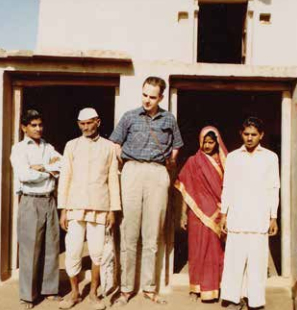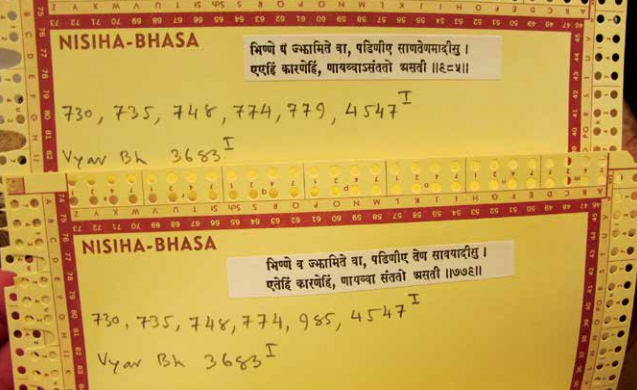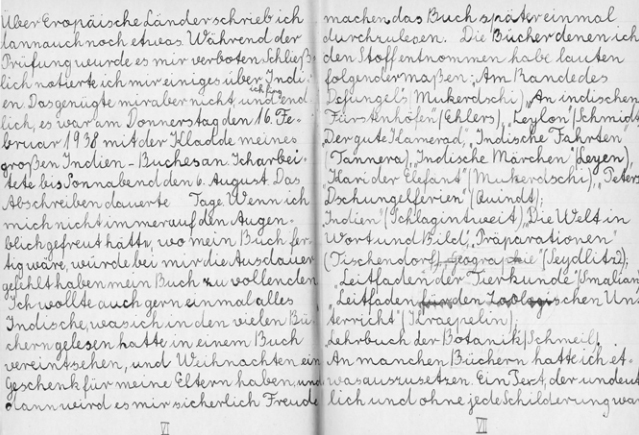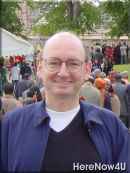
Centre of Jaina Studies Newsletter: SOAS - University of London
With the passing of Klaus Bruhn Jaina Studies has lost one of its most significant pillars and innovators, who nurtured the field over a period of 65 years.[1] Born in Hamburg as the only child of the Classical Philologist and Gymnasium teacher Dr Christian Bruhn (17.12.1884 2.2.1960) and his wife Ilse Bruhn (née Gürich, 16.2.18971.6.1983),[2] he served as an air force auxiliary at the age of 16 during the bombing of Hamburg in 1944-45. After the war, between 1947 and 1954, he studied Indology, Philosophy and Theology (later: Indo-European Studies) at the University of Hamburg. His main teachers were Walther Schubring, who retired in 1951, and Schubring's former pupil and successor Ludwig Alsdorf. Both attracted him to Jaina Studies, which would become the focus of his professional life.
Ludwig Alsdorf, a specialist of Prakrit and Pali prosody and Jaina legendary-historical literature, inspired the theme of Bruhn's doctoral dissertation on Jaina universal history, Śīlānka's Cauppaṇṇamahāpurisacariya: Ein Beitrag zur Kenntnis der Jaina-Universalgeschichte (Hamburg: De Gruyter, 1954). Having procured photographs of two palm leaf and one paper manuscript of Śīlānka's Prakrit text from Muni Puṇyavijaya, Alsdorf proposed that Bruhn undertake a comparison of the Cauppaṇṇamahāpurisacariya with Hemacandra's Sanskrit Triṣaṣṭiśalākāpuruṣacaritra. Yet, other versions of the universal history, especially the older Āvaśyakaniryukti, needed to be taken into account as well. An important contribution of Bruhn's resulting study to Indology was the systematic application of the comparative method, focusing on structural patterns, literary forms, and the question of the degree of 'combination', 'mixture', 'fusion' or 'duplication' of traditions, which he analysed with the help of conspectuses. Form analysis would remain one of the principal concerns throughout Bruhn's career.
In addition to the well-known pattern of 'nested' stories, Bruhn discovered the principle of 'entanglement/ disentanglement', which he found frequently employed in early biographical texts, where life-stories are not always narrated in their natural sequence, but split up into parts, which then are re-assembled in different ways. The main focus of his form analysis was the careful distinction between the individual and the typical. The challenge was to take account of the Jaina 'inclination for typification', leading to 'multiplication' as well as to 'division', both resulting in the creation of 'series', such as biographies representing features of the type besides individual features, or of variations of themes. In the course of his typological investigations, Bruhn developed the firm conviction that a single text cannot be properly understood without considering parallel texts.[3] Jaina universal history as a whole and its parts must also be seen in the light of non-Jaina parallels. Bruhn concluded that Jainism had become the stereotypical 'religion without dogmatic development' because it constrained its own options by developing an increasingly systematised philosophical framework, which in turn exerted an influence on the narrative religious literature.

Figure 1. Klaus Bruhn and the family of Shri Ram Dayal Jain, Pūjārī of the Jaina temples at Deogarh (Photo: Krishna Bruhn 1963).
Another major outcome of the study was the analysis of the structure and development of the biography of Mahāvīra, presented in the context of the overall evolution of the Tīrthaṅkara biography and the systematisation of Jaina universal history. Because an English summary of this pioneering work was published only as an introduction to A. M. Bhojak's subsequent full text edition of the Cauppaṇṇamahāpurisacariya, a publication wellknown only to Prakrit specialists,[4] Bruhn's findings on the history of the Mahāvīra biography, though of fundamental importance for the history of religions, are still not widely known, nor are they reflected in the textbooks that appeared after Glasenapp (1925) and Schubring (1935).
After his doctorate Bruhn spent three years at the Deccan College in Pune, sponsored by a scholarship of the Government of India, and in the village of Deogarh (M.P.) to conduct fieldwork for his Habilitation on the iconography of its ancient Digambara temples. The topic had been inspired by U.P. Shah, whom he had visited in Baroda in 1954 only to find out that the former had already started a project on the links between the Daśavaikālika-cūrṇi and Jaina iconography which Alsdorf had suggested to Bruhn. On his return from India, Bruhn was appointed as Alsdorf's University Assistant. After a fourth visit to Deogarh in 1963 (Figures 1 and 2), now together with his then recently wedded wife Dr Krishna Bruhn (née Swarup), a Humboldt Fellow whom he had met in Hamburg, the work Die Jina-Bildnisse von Deogarh was finally completed in 1964, and published in 1969 in an English translation by Michael McDonald: The Jina-Images of Deogarh (Leiden: E.J. Brill, 1969). For Bruhn, moving from the study of post-canonical Jaina literature to the history of Jaina iconography did not represent a major change of orientation, because for him the study of Jaina iconography was intrinsically connected with the study of Jaina literature.
His second major work was not only an impeccable documentation of important cultural relics, which already in 1957 had begun to be destroyed by art thieves and by renovation. It introduced an entirely new approach to Indian Art History, giving account for the unusual stylistic complexity of the evidence, namely, an analytical vocabulary for the formal description of the Deogarh material, based on the identification of concrete iconographic and stylistic types through an exhaustive classification of recurring elements and variations. The method was an adaptation and elaboration of his earlier approach to Jaina narrative literature. Because the 'types of types', the analytical categories generated through the identification of (partial) similarities of characteristics between two or more 'forms', 'systems', 'attributes' and 'form-principles', differed from the terms found in old 'art-theoretical' Sanskrit texts, Bruhn's innovative chapter on method was entirely ignored by reviewers in Indian Art History, and found few followers beyond the circle of his immediate disciples. The same can be said of his later refinements of the method of concrete description, introducing 'frame-' and 'slot-filler' analysis, etc., in a series of pioneering articles on 'Distinction in Indian Iconography' (1960), 'Wiederholung in der indischen Ikonographie' (1973), 'The Identification of Jina Images' (1985), 'The Analysis of Jina Images' (1986), 'The Grammar of Jina Iconography I & II' (1995, 2000), 'Early Jaina Iconography (an Overview)' (2010), and works on Jaina Miniature Paintings from Western India (2004, 2005, 2006, 2010), amongst others. Bruhn's work on Jaina iconography was far ahead of its time and will almost certainly be re-discovered by a new generation of scholars.
In 1965, the Freie Universität Berlin (FU-Berlin) appointed Bruhn as a temporary replacement for Schubring's disciple Frank-Richard Hamm (1920-1973), and in 1966 as his successor to the Chair for Indology at the Institute of Indian Philology and Art History, a position he held until his retirement in 1991. As Chair, Bruhn initiated important research collaborations, particularly in Jaina Studies. In the years 1968-76 he received successive grants from the German Research Foundation (DFG) for the creation of a concordance of verses of the vast but little-studied early Jaina exegetical literature, the Niryuktis and Bhāṣyas and related (Digambara) texts. The aim was to trace parallels, to find out to what extent these largely anonymous, heterogeneous works are independent texts, and as a tool for the creation of critical editions and sample studies of works such as the Āvaśyakaniryukti, which Ernst Leumann had begun to investigate in the 19th century. The project Erstellung einer Konkordanz zur Jaina-Literatur was completed in Berlin together with Chandrabhāl B. Tripaṭhī and Bansidhar Bhatt.[5]

Figure 2. Klaus Bruhn and children of Deogarh (Photo: Krishna Bruhn 1963).
Work was conducted in a pragmatic spirit. Hence, the Sthānakavāsī Muni Phūlcand's (Pupphabhikkhu) edition of the Siddhānta was utilised, because at the time it was the only easily available complete imprint of the primary sources, despite the fact that all references to temples had been eliminated by the editor. First, all texts were photocopied, then individual verses cut out, glued on individual punch cards, and finally cross-referenced. The original plan to use computers was abandoned as far as possible 'because only the editors themselves could cope with the textual criticism of the uncommonly numerous variant readings'.[6] The resulting alphabetically structured punch-card-catalogue was presented by Bruhn to visitors as the showpiece of the Institute. After the tragic closure of the Institute in 2008, and hence the end of Indology in Berlin for the foreseeable future, the eight cabinets, containing drawers holding the cards of some 50,000 cross-referenced verses, were in 2009 bestowed by Bruhn to the British Library, because the authorities of the FU-Berlin had refused to host them.[7] (Figure 3)

Figure 3. Punch-Cards of the Berliner-Konkordanz at the British Library. (Photo: Peter Flügel 7.2.2017)
In the 1980s and 1990s, Bruhn published important research articles related to the Jaina-Concordance. Most significant were his two expansive essays 'ĀvaśyakaStudies I' (1981) and 'Repetition in Jaina Narrative Literature' (1983), followed by two kindred works on 'Das Kanonproblem bei den Jainas' and 'Soteriology in Early Jainism' (1987). Using the punch cards as tools for 'micro-studies' to good effect, Bruhn also produced 'The Kaṣāya Concept in Jaina Soteriology' (1992), and 'The Concept of Māna (Pride) in Jaina Dogmatics' (1993). Yet, he never mustered 'the courage', he later wrote, to take up the work on the Āvaśyaka-literature where Leumann had left it in 1900, despite its significance for Jaina universal history, philosophy, and ritual.[8] Bruhn officially terminated his own investigations of the old exegetical literature with 'Ludwig Alsdorf's Studies in the Āryā' (1996) and finally with the 'Bibliography of Studies Connected with the Āvaśyaka-Commentaries' (1998).
Bruhn collaborated extensively with other scholars and inspired much research in Jaina Studies and beyond. With Herbert Härtel he started the series Indologia Berolinensis in 1969, which published five outstanding doctoral dissertations and habilitations in Indology and Art History at the FU-Berlin, the last two of them in Jaina Studies (M. Horstmann 1969, P. Werner 1972, M. Pfeiffer 1972, C. Tripathi 1975, B. Bhatt 1978). In 1985, the first volume of the Berliner Indologische Studien (BIS) appeared, a journal established by Bruhn and his colleagues, in the name of the Institute of Indian Philology and Art History, to facilitate swift publication of essays, some of which would not easily fit into existing Indological or Art Historical journals. Effectively, BIS was his own publication series, and was run with the help of his assistants. Bruhn dedicated an extraordinary amount of time and effort to the editing of the Indologia Berolinensis and on the contributions to BIS, which he tended to discuss almost line by line with authors in extensive phone calls. The current culture of publishing quickly and point-scoring was not on his radar. From 2007 he officially signed on as editor of BIS together with Gerd J. R. Mevissen, not least, because from this time onward the publication was completely self-financed. In this way its continuity was secured after the closure of the Institute in 2008.
More than any other scholar in the field of Jaina Studies, and arguably in Indology and Indian Art History in general, Bruhn wrote in a methodologically selfreflective way. Though he rejected abstract theorising in favour of detailed formal description, he identified the problem of (provisional) reduction of complexity as one of the main tasks of Jaina Studies, and became increasingly concerned with questions of delineating viable research strategies for the field as a whole. Though fiercely defensive of the historical-philological method of Classical Indology, compared to the canon-oriented approach favoured in the Study of Religions, and the formalistic approaches of Linguistics or the Social Sciences, he began to advocate 'experimental learning' and methodological pluralism, while increasingly appreciating the advantages of collaborative, even interdisciplinary approaches for a comprehensive investigation of the Jaina materials. At the same time, he privileged micro-studies of strategically selected phenomena, which he called Probebohrungen, in his own case mainly focussing on Jaina ethics. In order to give 'Jaina Studies' a sound methodological foundation, and to relate macro- and micro-research strategies in non-arbitrary ways, he devised the concept of 'Sectional Studies' for Jainology (1991, 1993). The basic idea was to pragmatically divide a 'frame subject' such as 'Jainism' into thematic sub-subjects or 'sections', concrete or abstract, to be studied to the required depth, step by step. This was done by 'segmentation' of given data, a whole work or group of works, into manageable portions, leading to viable research-schemes. In Bruhn's view, only the conscious segmentation of the material, involving the construction of classifications and concrete models, permitted the systematic study of different aspects of (for instance) Jaina culture in a methodologically controlled way, and significantly expanded analytical possibilities, compared to the approaches of Classical Indology or the Study of Religions. Although his proposed tabulations seemed rather tedious and artificial to many scholars, hence 'typically German', for the first time in the field, the usually unarticulated decisions that have to be taken in the actual process of research were explicated and laid open for discussion.
Notable outcomes of Bruhn's work on the section 'Jaina Ethics', besides an online translation of 'Five Vows and Six Avashyakas: The Fundamentals of Jaina Ethics' (1997-8), were three magisterial articles, which should be required reading for any university course on Jainism: the belatedly published essay 'Die Ahiṃsā in der Ethik des Jaina-Autors Amṛtacandra' (2007), 'Ācārāṅga Studies' (2004-5), and his truly pioneering work on 'The Mahāvratas in Early Jainism' (2003). His study on Jaina ethics concluded with 'Two Overviews [I. Structure of Jainism (sects and schools); II. Terms in Jaina ethics (the canon)]' (BIS 2012).
Professor Klaus Bruhn was a scholar of rare acumen, dedication and integrity, an explorer in the true sense of the term. Always dissatisfied with his own considerable knowledge, and the very slow advances in his field of study, he never sat comfortably on a task accomplished or a halfway solution reached. He seemed to experience a sense of despair in the face of the overwhelming mass of yet unstudied sources, which he had to leave behind to new generations of researchers. His research articles reflect this even more than his second book, on Deogarh, which he described as an 'inventory' instead of a 'monograph'. Rather than offering translations or a coherent argument on a selected point of interest, his publications always sought to address entire fields of complex facts, and to open up new questions for future investigations. They were deliberately openended conspectuses, providing sometimes hard to ingest mixtures of highly detailed evidences and playful experiments with new interpretative perspectives. The intended readership of these avant-garde treatises was clearly limited. Occasionally, Bruhn seemed to speak mainly to himself when he noted changes in his views in response to new publications in the field, which he extensively commented upon. Despite having published mainly in English, the work of Klaus Bruhn received less attention than it deserved, principally because of its complexity and style. Reviewers showed little understanding of his innovations. However, Bruhn's self-confidence and enthusiasm for Jaina Studies helped him cope with his splendid isolation at the apex of the field.
Bruhn was by no means an ivory-tower academic. He was the founding co-chair of the Deutsch-Indische Gesellschaft Berlin, which was established in 1971, and regularly interacted with the local Indian communities. He also engaged critically, and publicly, with some of the anti-liberal excesses of the reform agenda of the radical German student movement of the 1960s and 1970s, including those of the 'Red Cell Indology' at the FU-Berlin, which he tolerated.[9] His intellectual response was the short work Die zweite Reform (Leiden: E.J. Brill, 1973), which he composed together with the Berlin musicologist Rudolph Stephan, offering a 'phenomenology of progressiveness', a discourse analysis of the reductive asymmetric binary oppositions which were frequently used by 'progressives' (and antiprogressives) to provide easy answers, at the cost of 'explosions of synonyms'. The small tractatus put forth the case for the preservation of the 'small disciplines' in the Humanities and for academic freedom, which in the view of the authors was endangered by quantitative reduction, instrumentalisation by the (Marxist) social sciences, and the so-called second reform, that is, the re-definition of the curriculum in the name of student participation and emancipation. At the same time, the authors advocated for 'impartiality vis-à-vis the new possibilities' that were opened by the loosening of ossified structures and the introduction of new methodologies. Better than in any of his methodological articles, sometimes composed in an extremely condensed telegram style, the credo of Bruhn's scholarly approach is expressed here: not reducing but expanding analytical possibilities, generating further insight rather than settling for final truths, looking at a chosen phenomenon from as many perspectives as are fruitful and necessary. In one of his articles he characterised himself with the help of an expression of A. O. Lovejoy as 'habitually sensible of the general complexity of things'.
Throughout his life Bruhn had always been enthusiastic about matters Indian. (Figure 4) He also supported non-academic initiatives and marginal figures who produced valuable work. Likely he regarded himself sometimes as a fringe figure as well, because he straddled disciplinary boundaries and published articles that did not easily fit in the traditional Indological format. Bruhn did not leave any extensive translations, but rather case studies and specimens, focused on comparative analysis of textual and iconographic materials, with indications even for desirable social scientific research. For his teachers W. Schubring and L. Alsdorf he published three important edited volumes: Schubring's mildly overedited Kleine Schriften (1977), Studien zum Jainismus und Buddhismus: Gedenkschrift für Ludwig Alsdorf (1981), and, with Magdalene Duckwitz and Albrecht Wezler, Ludwig Alsdorf and Indian Studies (1990), while he himself was presented with a Festschrift with contributions from disciples, friends and colleagues, edited by Nalini Balbir and Joachim K. Bautze (1994).

Figure 4. Excerpt from 'Indische Geographie' (1938), written by Bruhn at the age of ten. In response to the author's query, he related that his fascination with India had been awakened when he was a boy by adventure novels set in the Subcontinent (Institute of Ethnology, FU-Berlin 21.11.1998). His wife Krishna Bruhn reported on 31.1.2017 that their daughters Malini Bruhn and Nandini Bruhn unexpectedly found in his literary estate four book manuscripts which their father had written as a boy: 'Walter in Indien' (1937), 'Indische Geographie' (1938), 'Eine kurze Schilderung der 'Indischen Geschichte und der Freiheitsbestrebungen der Inder' (1941), and 'Gedanken zur Indischen Kunst' (1942). In the manuscript of 1938, he listed the books that had influenced him: first of all William Quindt's Peters Dschungelferien: Was ein deutscher Junge in den Wäldern Indiens erlebte (Stuttgart 1934) and Maximilian Kern's Im Labyrinth des Ganges (Stuttgart 1907), followed by Dhan Gopal Mukerdschi's (Mukherji) Am Rande des Dschungels [Hari, the Jungle Lad] (Berlin 1927), and Kari, der Elefant [Kari, the Elephant] (Frankfurt 1929), travel literature such as Otto E. Ehlers's An indischen Fürstenhöfen (Berlin 1894), as well as Emil Schlagintweit's Indien in Wort und Bild (Leipzig 1880-81) and other non-fiction works.
In 2006 Bruhn was awarded the Prakrit Jñānabhāratī International Award by the National Institute of Prakrit Studies and Research at Śravaṇabeḷagoḷa.[10] He donated the prize money to a children's hospital in India and to a charity benefitting impoverished women and children around the world. His last book, The Predicament of Women in Ancient India, was published both online and in print in 2008.[11]
Klaus Bruhn was an example to us all. In his very unique ways he represented in the best possible sense the cultural type associated with the city of Hamburg: modest, restrained, upright, learned, open minded, and good humoured. The words of one of his colleagues at the FU-Berlin characterise him very well: Klaus Bruhn was ein feiner Mensch.
For K. Bruhn's biography and bibliography see P. F. Krüger & G. J. R. Mevissen. 'Obituary: In Memory of Klaus Bruhn (1928-2016)'. Berliner Indologische Studien 23 (2017) 7-14.
See W. B. Bollée & K. Bruhn 'Prakrit Jñānabhāratī International Awards 2005-2006 Ceremony: Addresses by Prof Dr Willem Bollée and Prof Dr Klaus Bruhn'. Jaina Studies Newsletter of the Centre of Jaina Studies 4 (2009) 18-21, p. 20.
K. Bruhn, 'Introduction to Śīlāṅka's Cauppaṇṇamahāpurisacariya'. Cauppaṇṇamahāpurisacariyam by Ācārya Śrī Śīlāṅka. Ed. Amritlal Mohanlal Bhojak, 1-31. Ahmadabad: Prakrit Text Society, 1961.
Bruhn, K. & C. Tripathi. 'Jaina Concordance and Bhāṣya Concordance'. Beiträge zur Indienforschung. Ernst Waldschmidt zum 80. Geburtstag gewidmet. Hg. H.Härtel, 67-80. Berlin: Museum für Indische Kunst, 1977.
E. Strandberg, 'Lexicography of Middle-Indo-Aryan'. Wörterbücher - Dictionaries - Dictionnaires: Ein Internationales Handbuch zur Lexikographie. Ed. F. J. Hausmann, O. Reichmann, H. E. Wiegland, L. Zgusta. Vol. 3, 2497-2507. Berlin: De Gruyter, 1991, p. 2503.
On recommendation of the present writer, Michael O'Keefe, Head of South Asia Collections of the British Library, secured the preservation of this important research tool..
 Dr. Peter Flügel
Dr. Peter Flügel